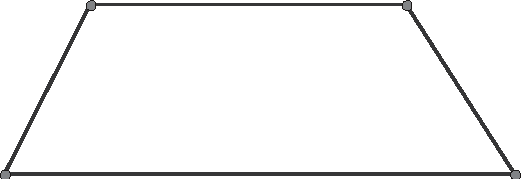Geometry: Properties of Trapezoids
Properties of Trapezoids
A trapezoid is a quadrilateral with exactly two parallel sides. Figure 15.1 shows trapezoid ABCD. Remember the naming conventions for polygons. You must list the vertices in consecutive order. In trapezoid ABCD, ¯BC ¯AD. The parallel sides ¯BC and ¯AD are called the bases, and the nonparallel sides ¯AB and ¯CD are legs. Base angles are a pair of angles that share a common base. In Figure 15.1, ∠A and ∠D form one set of base angles.

Figure 15.1The trapezoid ABCD.
When the midpoints of the two legs of a trapezoid are joined together, the resulting segment is called the median of the trapezoid. In Figure 15.2, R and S are the midpoints of ¯AB and ¯CD, and ¯RS is the median of trapezoid ABCD. The median of a trapezoid is parallel to each base. Strangely enough, the length of the median of a trapezoid equals one-half the sum of the lengths of the two bases. Accept these statements as theorems (without proof), and use them when needed.

Figure 15.2R and S are the midpoints of ¯AB and ¯CD, and ¯RS is the median of trapezoid ABCD.
- Theorem 15.1: The median of a trapezoid is parallel to each base.
- Theorem 15.2: The length of the median of a trapezoid equals one-half the sum of the lengths of the two bases.
- Example 1: In trapezoid ABCD, ¯BC ¯AD, R is the midpoint of ¯AB and S is the midpoint of ¯CD, as shown in Figure 15.3. Find AD, BC, and RS if BC = 2x, RX = 4x − 25 and AD = 3x − 5.

Figure 15.3Trapezoid ABCD, ¯BC ¯AD ¯AB has midpoint R and ¯CD has midpoint S.
- Solution: Because RS = 1/2(AD + BC), you can substitute the values for each segment length:
- 4x − 25 = 1/2(3x − 5 + 2x)
- Rearranging and simplifying gives:
- 4x − 25 = 5/2x - 5/2
- 4x − 5/2x = 25 - 5/2
- 3/2x = 45/2
- x = 15
- So, x = 15, BC = 30, RS = 35, and AD = 40.
An altitude of a trapezoid is a perpendicular line segment from a vertex of one base to the other base (or to an extension of that base). In Figure 15.4, ¯BT is an altitude of trapezoid ABCD.

Figure 15.4The trapezoid ABCD, with altitude ¯BT.
Solid Facts
A trapezoid is a quadrilateral with exactly two parallel sides.
The bases of a trapezoid are the parallel sides.
The legs of a trapezoid are the nonparallel sides.
The median of a trapezoid is the line segment joining the midpoints of the two legs.
An altitude of a trapezoid is a perpendicular line segment from a vertex of one base to the other base (or to an extension of that base).
Base angles of a trapezoid are a pair of angles that share a common base.
Built into the trapezoid are two parallel lines (the bases ¯BC and ¯AD) cut by a transversal (one of the legs, either ¯AB or ¯CD). You know that the two interior angles on the same side of the transversal are supplementary angles (Theorem 10.5), so ∠A and ∠B are supplementary angles, as are ∠C and ∠D.
Excerpted from The Complete Idiot's Guide to Geometry © 2004 by Denise Szecsei, Ph.D.. All rights reserved including the right of reproduction in whole or in part in any form. Used by arrangement with Alpha Books, a member of Penguin Group (USA) Inc.
To order this book direct from the publisher, visit the Penguin USA website or call 1-800-253-6476. You can also purchase this book at Amazon.com and Barnes & Noble.







